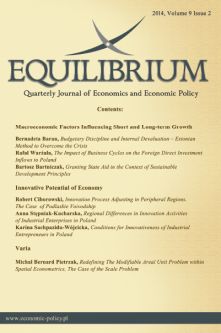Budgetary Discipline and Internal Devaluation – Estonian Method to Overcome the Crisis
Budgetary Discipline and Internal Devaluation – Estonian Method to Overcome the Crisis
Author(s): Bernadeta BaranSubject(s): Economy
Published by: Instytut Badań Gospodarczych
Keywords: internal devaluation; budgetary adjustments; competitiveness; crisis
Summary/Abstract: The purpose of this article is to outline the main reasons and effects of the Estonian adjustments in response to the global financial and economic crisis. Estonia chose significant budgetary savings, in contrast with most other countries stimulating their economies by expansionary fiscal policy and leading to fiscal imbalances and growing public debts. Estonia did not carry out a devaluation of its currency, but restored competitiveness through internal devaluation. This strategy allowed Estonia to maintain a fixed exchange rate, fulfill the Maastricht criteria and adopt the single currency. As a result, Estonia has increased the stability of its economy, restoring and enhancing confidence among investors. At the same time, the Estonian strategy confirmed the existence of non-Keynesian effects – the positive economic results of public spending reduction.
Journal: Equilibrium. Quarterly Journal of Economics and Economic Policy
- Issue Year: 9/2014
- Issue No: 2
- Page Range: 9-23
- Page Count: 14
- Language: English

